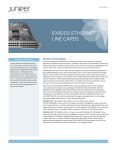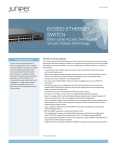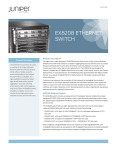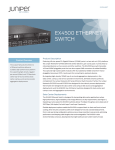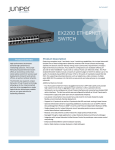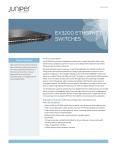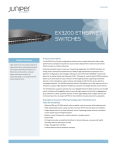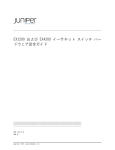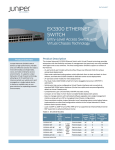Download Juniper EX8200-48T network switch module
Transcript
DATASHEET EX8200 ETHERNET LINE CARDS Product Overview Juniper Networks EX8200 Ethernet line cards offer a variety of interfaces for supporting high-density 100 Mbps, Product Description The Juniper Networks® EX8200 line of Ethernet switches offer powerful, modular platforms that deliver the performance, scalability, and carrier-class reliability required for today’s high-density enterprise data center access and core and campus aggregation and core environments, as well as high-performance service provider interconnects. Gigabit and 10 Gigabit Ethernet (GbE) EX8200 Ethernet line cards are specifically designed to optimize enterprise applications. deployments. Working with the Juniper Each EX8200 Ethernet line card includes either two or four on-board Packet Forwarding Networks EX8208 eight-slot and Engines—the EX-PFE2—that are equipped with two purpose-built, application-specific EX8216 16-slot modular Ethernet switch integrated circuits (ASICs), one to perform wire-speed packet processing at line rates, and chassis, the EX8200 Ethernet line cards another to perform internal deep packet queuing and buffering while providing a high- offer flexible, high-density interfaces speed interface to the chassis switch fabric. In addition, each line card contains a local for high-performance data center processor which provides scalable local control and status processing. and campus aggregation and core Four versions of the EX8200 Ethernet line cards are available, each of which supports environments. a consistent set of features and capabilities: the EX8200-48T, the EX8200-48F, the EX8200-8XS and the EX8200-40XS. EX8200-48T: The EX8200-48T Ethernet line card offers wire-rate 48 10/100/1000BASE-T ports with RJ-45 copper connectors. Designed for data center endof-row server access, or campus applications where high densities, high performance, and high availability over copper links of up to 100 m are required, the EX8200-48T enables up to 384 line-rate ports in a single EX8208 chassis, or 768 ports in an EX8216 chassis. EX8200-48F: The EX8200-48F is a 48-port wire-rate 100BASE-FX/1000BASE-X line card with modular small form-factor pluggable transceiver (SFP) interfaces for supporting a wide range of 100 Mbps or Gigabit Ethernet optical connections over multimode fiber, single-mode fiber, or copper cabling. Designed for high-performance enterprise and service provider distribution applications, the EX8200-48F also enables up to 384 linerate ports in an EX8208 chassis, and 768 ports in an EX8216 chassis. EX8200-8XS: The EX8200-8XS is an eight-port 10GBASE-X line card with compact, modular SFP+ fiber optic interfaces, enabling up to 64 line-rate 10-Gigabit Ethernet ports in an EX8208 chassis and 128 ports in an EX8216 chassis. The EX8200-8XS is ideal for enterprise applications such as campus or data center uplink aggregation, core and backbone interconnects, and for service provider deployments requiring high- 1 density, wire-speed 10-Gigabit Ethernet interconnects in metro The switch fabric interface ASIC of the EX-PFE2 manages the area networks, Internet exchange points, and points of presence large ingress and egress buffers that provide congestion avoidance (POPs). The 10-Gigabit Ethernet port densities afforded by and traffic prioritization. On ingress, each switch fabric interface the EX8200-8XS line cards also enable EX8200 switches to queues packets based on destination using dedicated high- and consolidate aggregation and core layers in the data center, low-priority buffers for each wire-speed, 10-Gigabit Ethernet simplifying the network architecture and reducing power, space, egress port, or each group of 12 Gigabit Ethernet ports in the and cooling requirements while lowering total cost of ownership system. These weighted random early detection (WRED) virtual (TCO). output queues—up to 8,192 in an EX8216 chassis—prevent “head- EX8200-40XS: The EX8200-40XS is a 40-port oversubscribed 10GbE solution for data center end-of-row and middle-of-row server access, as well as for data center blade switch and top- of-line blocking” among ports on the same line card, ensuring complete independence of traffic flows among all 10-Gigabit Ethernet ports in the system. of-rack or campus uplink aggregation deployments. Optimized The switch fabric interface also manages the transfer of data for data center networks migrating from GbE to 10GbE interfaces across the distributed, single-tier crossbar switch fabric. Data is where simultaneous line-rate performance is not required on evenly distributed across the fabric to balance traffic load and all ports, the EX8200-40XS supports a wide range of both ensure graceful degradation of performance in the event of a non- SFP (GbE) and SFP+ (10 GbE) modular optical interfaces for redundant switch fabric failure. Multicast traffic is also balanced connecting over multimode fiber, single-mode fiber, and copper across the system using the same line-rate, binary-tree replication cabling. process as the Juniper Networks T Series Core Routers and the The 40 SFP/SFP+ ports on the EX8200-40XS are divided into 8 independent groups of 5 ports each. Because port groups Juniper Networks MX Series 3D Universal Edge Routers, minimizing fabric congestion while reducing latency. are independent of one another, each group can have its own On egress, the switch fabric interface provides eight dedicated oversubscription ratio, providing customers with maximum queues per port, mapped according to class of service (CoS) or deployment flexibility. Each group dedicates 10 gigabits per DiffServ code point (DSCP) values. A WRED scheduler is used for second (Gbps) of switching bandwidth to be dynamically congestion avoidance within each queue, while administrator- shared among the ports; queues are allocated within a 1MB configured strict and weighted round-robin priority options are oversubscription buffer based on the number of active ports in a available between queues on a single port. Multicast traffic is group and the types of interfaces installed. Users simply connect managed independent of unicast traffic. the cables and the EX8200-40XS automatically provisions each port group accordingly. No manual configuration is required. Total buffer size is 512 MB on each EX8200-8XS 10-Gigabit Ethernet port or each EX8200-40XS port group, and 42 MB The EX8200-40XS line card can satisfy either 10GbE or GbE on each EX8200-48T and EX8200-48F Gigabit Ethernet port, applications within each port group independently, providing the providing 50-100 ms of bandwidth delay buffering. These deep perfect migration vehicle for customers transitioning to higher- buffers and ingress and egress queuing mechanisms are critical speed connectivity. to managing mission-critical data, handling bursty traffic, Features and Benefits The EX8200 PFE2 complex is comprised of two ASICs: the packet processor and the switch fabric interface. The hardware pipeline on the packet processor ASIC supports approximately 960 Mpps of Layer 2 and Layer 3 IPv4 and IPv6 traffic in the EX8208, and more than 1900 Mpps in the EX8216. Wire-speed performance is maintained regardless of packet size, from 64- to 9216-byte jumbo frames across both L2 and L3 interfaces. Firewall (access and limiting TCP/IP retries at the application level to free up bandwidth, reduce latency and allow a higher quantity of both unicast and multicast application flows across the network. All packets pass through the entire EX-PFE2 ingress pipeline, the switch fabric, and the EX-PFE2 egress pipeline. This consistency of packet processing ensures that the EX-PFE2 is capable of delivering port-to-port latencies of under 10 μs, regardless of ingress or egress port location. control list) filtering, marking, and rate limiting also occur at wire Up to 255 link aggregation groups (LAGs) are supported, ensuring rate, with up to 64,000 entries across L2-L4 packet headers that that the large number of high-density Gigabit Ethernet LAGs found can be applied per port, per VLAN, and per routed interface. in campus and data center core and aggregation deployments can The packet processor ASIC also supports generic routing encapsulation (GRE) tunneling and two-label MPLS in hardware at line rate . Additional packet processor ASIC capabilities include multiple queues for CPU-bound control traffic to protect the Routing Engine from denial of service (DoS) attacks, and support for up to seven mirrored analyzer sessions directed to individual ports, VLANs, or tunneled interfaces. 2 be accommodated. Up to 12 ports may be bundled into a single LAG, allowing 120 Gbps logical interfaces to be created using a full L2-L4 hash algorithm for optimal load balancing. Ports in a LAG may be distributed across line cards within an EX8200 switch for an added level of resiliency. Automatic detection, recovery, and redistribution of LAG traffic in the event of a port, link, or line card failure is supported for highly reliable connections. Each line card contains a local CPU that is connected to the to the Routing Engine. A second processor resident on each line chassis’ redundant Routing Engines over dedicated internal card aggregates flow-based statistics and analyzes sampled gigabit control-plane links. This CPU manages the local line card packets without impacting control plane performance. Finally, components, distributes forwarding table and other control plane hot insertion and removal of all line cards is supported for online data from the Routing Engine to the local EX-PFE2 ASICs, and maintenance and support. returns line card status and CPU-directed control plane packets EX8200 Ethernet Line Card Features at a Glance Features High availability • Hardware designed for continuous operation: -- Secure, modular architecture to isolate faults -- Separate control and forwarding planes to enhance scalability and resiliency -- Transparent failover and network recovery -- Graceful Route Engine Switchover (GRES) -- Nonstop Routing (NSR) Layer 2 features • Jumbo frames (9216 byte) • 4,096 VLANs • VLAN Registration Protocol (GVRP) • 802.3ad – Link Aggregation Control Protocol (LACP) • 802.1D – Spanning Tree Protocol (STP) • 802.1w – Rapid Spanning Tree (RSTP) • 802.1s – Multiple Instance Spanning Tree (MSTP) • Redundant Trunk Group (RTG) • VLAN Spanning Tree Protocol (VSTP) Layer 3 features • Static routing • RIP v1/v2 • OSPF v2 • Filter-based forwarding • Virtual Router Redundancy Protocol (VRRP) • BGP (Advanced Feature license) • IS-IS (Advanced Feature license) • IPv6 (Advanced Feature license) • Bidirectional Forwarding Detection protocol (BFD) Hardware tunneling • GRE tunnels (Advanced feature license*) • MPLS capabilities (Advanced feature license*) Multicast • Internet Group Management Protocol (IGMP) v1/v2/v3 • IGMP snooping • Protocol Independent Multicast PIM-SM, PIM-SSM, PIM-DM, MSDP Firewall filters • Ingress and egress L2-L4 access control lists (ACLs): – Port ACLs – VLAN ACLs – Routed ACLs • Control plane denial of service (DoS) protection QoS • 2,000 policers • 8 egress queues per port • Weighted Random Early Drop (WRED) scheduling • Scheduled Deficit Weighted Round Robin (SDWRR) queuing • Strict Priority queuing • Egress per port and per queue shaping • Multi-field classification (L2 – L4) for scheduling and rewrite Convergence • Full support for standards-based CEE / DCB (EX8200-40XS only)* * Roadmap 3 EX8200-48T EX8200-48F EX8200-8XS EX8200-40XS EX8200 Ethernet Line Card Specifications EX8200-48T EX8200-48F EX8200-8XS EX8200-40XS Port quantity 48 48 8 40 Port type RJ-45 SFP SFP+ SFP/SFP+ Port speed 10/100/1000 Mbps 100/1000 Mbps 10 Gbps 1 Gbps/10Gbps Max ports per system 384 (EX8208); 768 (EX8216) 384 (EX8208); 768 (EX8216) 64 (EX8208); 128 (EX8216) 320 (EX8208); 640 (EX8216) Forwarding rate 71 Mpps 71 Mpps 119 Mpps 119 Mpps Data rate 48 Gbps 48 Gbps 80 Gbps 80 Gbps Fabric connection 80 Gbps (160 Gbps full duplex) 80 Gbps (160 Gbps full duplex) 160 Gbps (320 Gbps full duplex) 160 Gbps (320 Gbps full duplex) Queues per port 8 per port 8 per port 8 per port Ingress: 6 per port group Egress: 8 per port and 8 per port group Policers 2,000 2,000 2,000 3,000 Total buffer size 42 MB per port 42 MB per port 512 MB per port 1 MB per port group 512 MB per port group within the PFE Scheduler WRED, SDWRR WRED, SDWRR WRED, SDWRR SDWRR per port group at ingress; WRED, SDWRR Jumbo frames 9216 bytes 9216 bytes 9216 bytes 9216 bytes LAG (ports/groups) 12/255 12/255 12/255 12/255 MAC addresses 160,000 160,000 160,000 160,000 IPv4 unicast routes* 500,000 500,000 500,000 500,000 IPv4 multicast routes* 128,000 128,000 128,000 256,000 IPv6 unicast routes* 256,000 256,000 256,000 128,000 IPv6 multicast routes* 128,000 128,000 128,000 64,000 VLANs 4,096 4,096 4,096 4,096 Firewall filters (ACLs) 54,000 entries 54,000 entries 54,000 entries 54,000 entries ARP entries 100,000 100,000 100,000 100,000 L3 next hops 220,000 220,000 220,000 220,000 Number of multicast groups 16,000 16,000 16,000 16,000 Analyzer sessions 7 (local or remote) 7 (local or remote) 7 (local or remote) 7 (local or remote) Max. power consumption 350 W 330 W 450 W 550 W Typical power consumption 194 W 185 W 299 W 427 W *Shared—total route capacity depends on prefix distribution 4 Specifications QoS Physical Specifications • Ingress policing: single rate 2 color • Hardware queues per port: 8 • Scheduling methods (egress): Strict priority (SP), Shaped Deficit Weighted Round-Robin (SDWRR) • 802.1p, DSCP/IP Precedence trust, classification, and marking • Layer 2-4 classification criteria: Interface, MAC address, Ethertype, 802.1p, VLAN, IP address, DSCP/IP Precedence, TCP/UDP port numbers, etc. • Egress WRED: Per queue per CoS threshold • CoS-based fabric ingress and egress queuing Dimensions (W x H x D): • 14.40 x 1.59 x 20.51 in (36.58 x 4.04 x 52.09 cm) Weight: • • • • EX8200-48T: 11.26 lb (5.11 kg) EX8200-48F: 13.26 lb (6.01 kg) EX8200-8XS: 15.30 lb (6.94 kg) EX8200-40XS: 15.30 lb (6.94 kg) Layer 2 Switching • • • • • • • • • • GVRP Physical port redundancy: Redundant trunk group (RTG) STP/RSTP (802.1D-2004) VSTP (Compatible with PVST+) STP enable/disable per port MSTP (802.1Q-2003) Number of MST instances supported: 64 LLDP RVI (Routed VLAN Interface) FCoE- and CEE-capable (EX8200-40XS)* Layer 3 Features: IPv4 • • • • • • • Routing protocols: RIPv1/v2, OSPF, BGP, IS-IS Static routing Routing policy Bidirectional Forwarding Detection Layer 3 redundancy: VRRP Layer 3 sub-interfaces IP directed broadcast Layer 3 Features: IPv6 • • • • • • • Routing protocols: RIPng, OSPFv3, BGP, IS-IS, PIM, MLD Static routing Routing policy Bidirectional Forwarding Detection Layer 3 redundancy: VRRPv6 Layer 3 sub-interfaces IP directed broadcast Access Control Lists (ACLs) (Junos® firewall filters) • • • • • Port-based ACL (PACL) – Ingress and Egress VLAN-based ACL (VACL) – Ingress and Egress Router-based ACL (RACL) – Ingress and Egress ACL counters Layer 2-4 classification criteria: Interface, MAC address, Ethertype, 802.1p, VLAN, IP address, DSCP/IP Precedence, TCP/ UDP port numbers, etc. • Control Plane DoS protection Link Aggregation • 802.3ad (LACP) support: - - Number of LAGs supported: 255 - - Max number of ports per LAG: 12 • LAG load-sharing algorithm: -- IP: S/D MAC, S/D IP - - TCP/UDP: S/D MAC, S/D IP, S/D Port - - Non-IP: S/D MAC • Tagged ports support in LAG Environmental Ranges • • • • • • Operating temperature: 32° to 104° F (0° to 40° C) Storage temperature: -40° to 158° F (-40° to 70° C) Operating altitude: up to 10,000 ft (3,048 m) Non-operating altitude: up to 16,000 ft (4,877 m) Relative humidity operating: 5% to 90% (non-condensing) Relative humidity non-operating: 0% to 95% (non-condensing) Safety and Compliance • CSA 60950-1 (2003) Safety of Information Technology Equipment • UL 60950-1 (2003) Safety of Information Technology Equipment • EN 60950-1 (2001) Safety of Information Technology Equipment • IEC 60950-1 (2001) Safety of Information Technology Equipment (with country deviations) • EN 60825-1 +A1+A2 (1994) Safety of Laser Products—Part 1: Equipment Classification • EN 60825-2 (2000) Safety of Laser Products—Part 2: Safety of Optical Fiber Comm. Systems • C-UL to CAN/CSA 22.2 No.60950-1(First Edition) • TUV/GS to EN 60950-1, Amendment A1-A4, A11 • CB-IEC60950-1, all country deviations • CE Electromagnetic Compatibility (EMC) • EN 300 386 V1.3.3 (2005) Telecom Network Equipment— EMC requirements • FCC Part 15 Class A (2007) USA Radiated Emissions • EN 55022 Class A (2006) European Radiated Emissions • VCCI Class A (2007) Japanese Radiated Emissions • ICES-003 Class A • AS/NZS CISPR 22 Class A • CISPR 22 Class A Immunity • EN 55024 +A1+A2 (1998) Information Technology Equipment Immunity Characteristics • EN-61000-3-2 (2006) Power Line Harmonics • EN-61000-3-3 +A1 +A2 +A3 (1995) Power Line Voltage Fluctuations • EN-61000-4-2 +A1 +A2 (1995) Electrostatic Discharge • EN-61000-4-3 +A1+A2 (2002) Radiated Immunity • EN-61000-4-4 (2004) Electrical Fast Transients • EN-61000-4-5 (2006) Surge • EN-61000-4-6 (2007) Immunity to Conducted Disturbances • EN-61000-4-11 (2004) Voltage Dips and Sags *Roadmap 5 Specifications (continued) Ordering Information Customer-Specific Requirements Model Number • GR-63-Core (2006) Network Equipment, Building Systems (NEBS) Physical Protection • GR-1089-Core (2006) EMC and Electrical Safety for Network Telecommunications Equipment • SR-3580 (1995) NEBS Criteria Levels (Level 3) (pending) Environmental • Reduction of Hazardous Substances (ROHS) 5/6 EX8200-48T 48-port 10/100/1000BASE-T RJ-45 line card EX8200-48F 48-port 100FX/1000BASE-X SFP line card; requires SFP optics sold separately EX8200-8XS 8-port 10GbE SFP+ line card; requires SFP+ optics sold separately EX8200-40XS 40-port GbE/10GbE SFP/SFP+ line card; requires SFP/SFP+ optics sold separately Telco • Common Language Equipment Identifier (CLEI) code Juniper Networks Services and Support Pluggable Optics EX-SFP-1GE-SX SFP 1000BASE-SX; LC connector; 850nm; 550m reach on multimode fiber EX-SFP-1GE-LX SFP 1000BASE-LX; LC connector; 1310nm; 10km reach on single-mode fiber EX-SFP-1GE-LX40K SFP 1000BASE-LX; LC connector; 1310nm; 40km reach on single-mode fiber EX-SFP-1GE-LH SFP 1000BASE-LH; LC connector; 1550nm; 70km reach on single-mode fiber EX-SFP-1GE-T SFP 10/100/1000BASE-T copper; 100m reach on UTP EX-SFP-1FE-FX SFP 100BASE-FX; LC connector; 1310nm; 2km reach on multimode fiber EX-SFP-10GE-SR SFP+ 10GBASE-SR; LC connector; 850nm; 300m reach on 50 microns multimode fiber; 33m on 62.5 microns multimode fiber EX-SFP-10GE-LRM SFP+ 10GBASE-LRM; LC connector; 1310nm; 220m reach on multimode fiber EX-SFP-10GE-LR SFP+ 10GBASE-LR; LC connector; 1310nm; 10km reach on single-mode fiber EX-SFP-10GE-ER SFP+ 10GBASE-ER; LC connector; 1550nm; 40km reach on single-mode fiber Juniper Networks is the leader in performance-enabling services and support, which are designed to accelerate, extend, and optimize your high-performance network. Our services allow you to bring revenue-generating capabilities online faster so you can realize bigger productivity gains and faster rollouts of new business models and ventures. At the same time, Juniper Networks ensures operational excellence by optimizing your network to maintain required levels of performance, reliability, and availability. For more details, please visit www.juniper.net/us/en/ Description Hardware products-services. About Juniper Networks Juniper Networks, Inc. is the leader in high-performance networking. Juniper offers a high-performance network infrastructure that creates a responsive and trusted environment for accelerating the deployment of services and applications over a single network. This fuels high-performance businesses. Additional information can be found at www.juniper.net. Corporate and Sales Headquarters APAC Headquarters EMEA Headquarters To purchase Juniper Networks solutions, Juniper Networks, Inc. Juniper Networks (Hong Kong) Juniper Networks Ireland please contact your Juniper Networks 1194 North Mathilda Avenue 26/F, Cityplaza One Airside Business Park Sunnyvale, CA 94089 USA 1111 King’s Road Swords, County Dublin, Ireland representative at 1-866-298-6428 or Phone: 888.JUNIPER (888.586.4737) Taikoo Shing, Hong Kong Phone: 35.31.8903.600 or 408.745.2000 Phone: 852.2332.3636 EMEA Sales: 00800.4586.4737 Fax: 408.745.2100 Fax: 852.2574.7803 Fax: 35.31.8903.601 www.juniper.net Copyright 2010 Juniper Networks, Inc. All rights reserved. Juniper Networks, the Juniper Networks logo, Junos, NetScreen, and ScreenOS are registered trademarks of Juniper Networks, Inc. in the United States and other countries. All other trademarks, service marks, registered marks, or registered service marks are the property of their respective owners. Juniper Networks assumes no responsibility for any inaccuracies in this document. Juniper Networks reserves the right to change, modify, transfer, or otherwise revise this publication without notice. 1000262-007-EN 6 Aug 2010 Printed on recycled paper authorized reseller.






